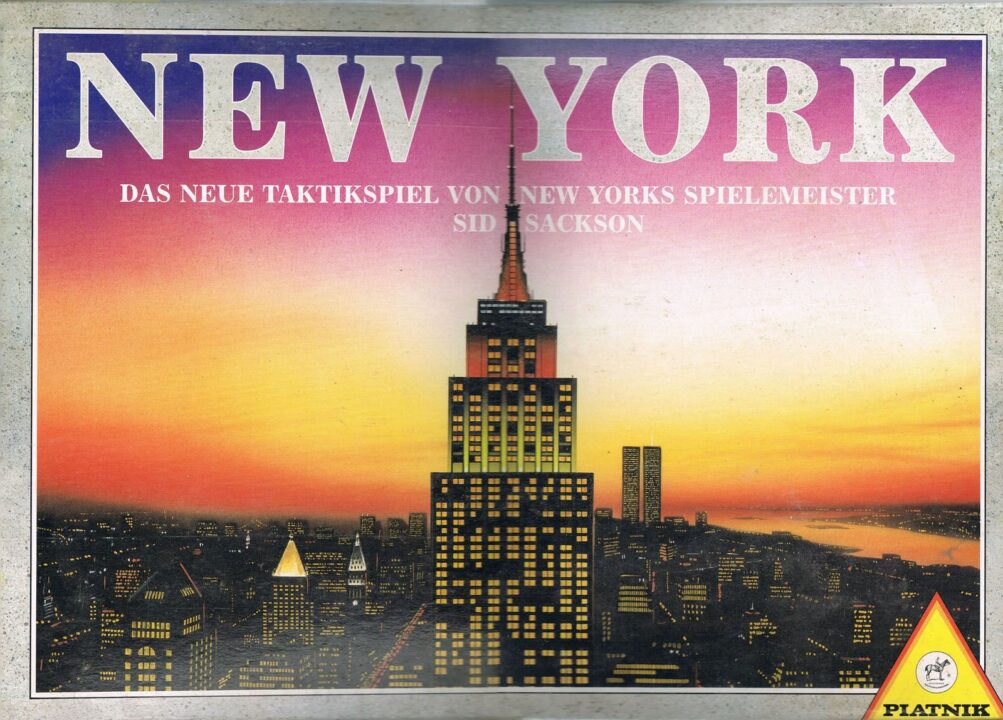Alright, let’s get this out of the way: my friends still complain about the time I made them play a board game with five dice rolls and no pizza. But, fear not! This is my review of New York, a game I brought out last game night hoping to redeem myself. Did it win the group over, or did I wind up in board game jail (again)? Grab your favorite snack, and let’s get this show on the road—without any endless rules or missing city taxis!
How It Plays
Setting up
First, toss the board on the table and give everyone their player pieces and cards. Make sure you sit near the snacks, or trust me, you’ll regret it. Place the building tiles in stacks and shuffle the deck. Lay out the city blocks, and you’re good to go.
Gameplay
Players take turns placing buildings, claiming spots, and playing sneaky cards to mess with others (like classic New Yorkers fighting for a parking spot). The game rewards blocking your friends and grabbing prime real estate before someone else does. But beware—sometimes the cards will mess with your master plan, leaving you wondering why you didn’t just stay home and watch Netflix.
Winning the game
When all the blocks are filled or the last card is played, everyone tallies up their points. Points come from completed areas, building types, and bonus objectives. Whoever has the highest score is crowned the Mayor of the Table, and gets to brag until next game night. If you lose, just remember: blaming New York traffic is a valid excuse.
Want to know more? Read our extensive strategy guide for New York.
Gameplay Mechanics and Player Interaction in New York
Let’s talk about how New York actually plays. First off, this game’s got a start-and-stop flow that’s smoother than a New York subway ride—on a good day, that is. Each turn, you’ll pick an action from a shared set: build up your skyscrapers, snap up choice properties, or throw a wrench in someone else’s plans. There’s a real sense of threat when you realize your best friend just stole the perfect plot of land. (I’m looking at you, Steve. Still not over it.)
There’s a bit of worker placement magic in here, but it isn’t your standard ‘put a meeple, get a thing’ deal. Half the fun is seeing your friends try to outguess you, then watching them fail spectacularly. And if you like player interaction, New York delivers. You bump elbows plenty—whether blocking tower spots or triggering events that hit everyone at the table. My group started the game as teammates and ended it eyeing each other like rival hot dog vendors at Coney Island.
On the downside, the luck factor pokes its head in from time to time—a badly timed card draw can turn your winning plan into a pile of rubble. Still, most victories feel earned, not given. I gave Steve the stink eye, not the game.
As you plot, scheme, and try to rule Manhattan, your eyes can’t help but wander over the board. So, next up, let’s see if New York looks good enough to hang on your wall—or if it’s about as artistic as a subway map drawn by a pigeon.
The Big Apple in Cardboard: New York’s Theme and Artwork
New York isn’t just a name on a box; it’s the real star of this board game. Right away, the artwork shouts at you like a Brooklyn hot dog vendor at lunchtime. The city skyline on the box is so shiny, my friends almost used it as a mirror to check their teeth for bagel bits. Once we got the board out, things only got better. The map of Manhattan had us squinting and pointing out spots: “That’s where I got lost last summer!” and “No way, they put a pizza joint next to Central Park!” Every corner of the board is packed with details that made us feel like we were actually elbowing tourists aside in Times Square.
The cards made us want to order a slice. Each one has fun little nods to the city—yellow cabs, subway signs, pretzel vendors. Even the meeples looked like they were late for a Broadway show. Someone at the table said it best: “This game has more New York in it than a bagel stuffed with pizza and pastrami.” The color choices are bold—nothing pastel here. It’s all yellow, blue, and orange—colors that say, “I’m walkin’ here!” The font is as loud as a taxi horn but still easy to read, even after a second root beer.
We did spot a few printing quirks, like a taxi cab with three wheels and one building topped with what may or may not be a squirrel, but that just added to the charm.
So, the art and theme pull you into New York like a strong breeze off the Hudson—next up, I’ll spill the beans about how luck and strategy duke it out in this game!
Is New York a Game of Brains or a Game of Chance?
Okay folks, here’s the million-dollar question: Does New York reward clever moves, or is it just the board game version of flipping a coin and hoping for the best? I’ve lost too many games on the last turn to shrug off the luck factor, so let’s get into the nitty gritty.
New York hands you choices every single turn. You pick where to place your buildings, you decide when to block rivals, and you try to predict what your friend who still hasn’t forgiven you for Monopoly 2015 is going to do next. Strategy absolutely matters. If you like playing 4D chess with your dinner guests, you’ll appreciate that the game is not just about winging it and hoping your pizza grease doesn’t ruin the cards.
But—and there’s always a but—luck isn’t shy in this city. Dice rolls can turn the tide, and card draws sometimes feel more like the city lottery than city planning. I’ve watched a perfectly laid plan unravel after a bad roll, while my buddy who plans like he’s lost in Central Park stumbles into victory. That can be hilarious or scream-at-the-box frustrating, depending on whether you’re the lucky winner or the strategic victim.
Still, there’s enough control that you won’t want to flip the table (unless you’re really into dramatic endings). So, New York mixes brains and chance like a hotdog vendor mixes ketchup and mustard—sometimes perfectly, sometimes it gets messy.
Now, before you run for the subway, stay with me: next up, I’ll spill the beans on replay value and whether New York drags longer than a rainy Manhattan traffic jam!
Is New York Worth Returning To? Replay Value and Game Length
If you’re like me and you occasionally lose at a game but refuse to admit it, replay value means everything. Some games hit the table once, then get buried under an avalanche of funko pops and regret. But does New York have what it takes to avoid the dreaded shelf of shame?
First, the game length. New York clocks in at around 45 minutes with three players, a perfect sweet spot for those who want more than a filler but don’t dream about eight-hour marathons. I played with both my chatty neighbor and my silent friend from accounting. Even with a few coffee refills and a mild argument about the correct way to pronounce “Houston” street, we finished in under an hour every time. It never overstays its welcome, even when someone forgets the rules (usually me).
Now, replay value. Each session shakes up the board in a way that makes coming back worth it. The random setup and a few optional rules keep things fresh. It’s like New York pizza — no two slices are ever the same, but you want another the second you finish one. Still, after a dozen plays, some combos felt a tad familiar. It won’t replace your Gloomhaven habit, but it doesn’t pretend to—think Sunday afternoon, not full-blown campaign night.
Verdict time! I recommend New York for most people, especially if you like quick, light games with enough bite to keep you coming back (but maybe not every week).
Conclusion
So that’s my review of New York! It’s a fun ride with zippy artwork, easy rules, and enough sneaky moves to keep everyone guessing. I had a blast every time I played, though the luck can swing things harder than a subway train at rush hour. If you like quick games with a city vibe—and you don’t mind a bit of chaos—this one’s worth a spot on your shelf. Just don’t expect every loss to be your fault! Thanks for reading, and see you at the table (unless you get stuck in traffic).


